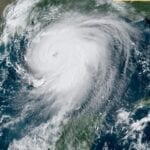While not a new occurrence, in recent years wildfires have wreaked havoc across the western U.S. We have also seen Mother Nature batter coastlines and landscapes around the globe, and the ever-mounting pace of these natural disasters serves as a warning about our own level of preparedness. As of now, the argument can be made that utility operators, governments, and even consumers are not doing enough to mitigate these potential risks. However, the technology to more efficiently mitigate and manage the risks of climate change, while promoting a more sustainable economy is already in existence. It just needs to be used more effectively to promote sustainability, safety, and ultimately bottom lines.
One area where this is particularly a challenge is our power grid, which is increasingly threatened by changing weather patterns and has become more strained over time to meet the needs of growing populations with new consumption patterns. A lack of efficient inspection capabilities and other outdated asset management techniques means that new risks arise across the grid—from substations to customers. Even the power lines themselves pose a risk, as the right mix of dry and windy conditions can quite literally spark fires.
This is top of mind for utilities, as the industry has witnessed spikes in company-imposed blackouts in wildfire-prone areas like California. While this practice has proven to be effective, it causes significant headaches to customers and is costly to conduct, leaving many to desire a more efficient way to manage the grid during these events.
Data Can Help Prevent Disaster
One way to limit the need for public safety power shutoffs is through the effective use of data. For example, utility companies often rely on manual or in-person line inspections, but given the sheer scale of activity across thousands of miles of utility lines and distribution substations, it can be tedious and challenging to conduct thorough examinations. In recent years, the industry has turned to technology for help.
This is where integrating Internet of Things (IoT) sensors, imaging, light detection and ranging (LiDAR), weather predictions, and other technologies into the grid helps operators identify disturbances or anomalies, analyze activity in the grid, and even receive real-time alerts regarding line interference. This is critical to stopping potential sparks or flames before they start. As this data is collected over time, the effective use of the information can reduce the risk of wildfires through the ability to take action when and where it’s needed—quickly and even preemptively.
However, these sensors, robots, and other monitoring tools generate mountains of data. While it can better inform future decisions, the scale and quality of data generated can be challenging to manage and effectively glean insights from. Thus, operators must look for ways to “liberate” this data from its silos in order to power data-driven insights that mitigate risk and protect employees, as well as consumers.
Liberate Data to Mitigate Risk and Boost Efficiency
The abundance of data at the disposal of utility companies and most organizations nowadays is unprecedented. The collection and storage of data has never been cheaper, but to get the maximum value out of data, and operate in a safer and smarter way, operators must be able to analyze and gather insights from the data before an impactful event occurs.
While gleaning insights from data may seem easy, it can be a major challenge when uncontextualized. That is why operators have struggled to this day, and also why utility companies and other heavy-asset industries are investing in data management. Through these investments, utility companies are working to make their organizational data more readily available and accessible to stakeholders. This allows all the data stemming from a utility company’s operation to be processed in milliseconds, meaning decisions can be made faster, with strong reasoning based on data, which is critical amidst a natural disaster such as a wildfire where every second counts and a misstep can result in catastrophe.
The liberation and contextualization of data to mitigate the risk of natural disasters is just one use case for utility companies. For example, large grid operators can use data to monitor the condition of distributed transformer networks. With data-driven insights, grid experts and employees can proactively identify risks (without manual inspections) and schedule maintenance—decreasing the likelihood of minor failures, as well as major failures.
The Technology Is Ready and Waiting
Humanity’s continued fight against Mother Nature has gone on for millennia, but we are no longer completely powerless in mitigating the impact and destruction of wildfires and other natural disasters. The proper use of data is our best defense.
Collecting it is no longer enough, power companies must proactively fuse their data, making it easily and quickly available to all stakeholders. This technology exists today, and is already being implemented by leading U.S. operators and other forward-looking companies around the world. To not only survive the energy transition, but also the effects of climate change on operations, data must be put to work.
—Francois Laborie, PhD is president of Cognite North America.










